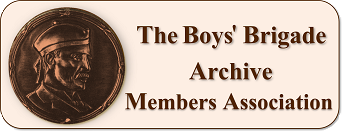Thank you for visiting this site. Unfortunately, the Boys' Brigade Archive Members' Association ceased to operate with effect from 31st December 2023.
Its role has now been taken by the Boys' Brigade Archive Trust - https://www.thebbmuseum.org/
Email Contact: This email address is being protected from spambots. You need JavaScript enabled to view it.
Thank you for visiting this site. Unfortunately, the Boys' Brigade Archive Members' Association ceased to operate with effect from 31st December 2023.
Its role has now been taken by the Boys' Brigade Archive Trust - https://www.thebbmuseum.org/
Email Contact: This email address is being protected from spambots. You need JavaScript enabled to view it.
At 8.00 p.m. on Thursday 4th October 1883, in Glasgow, Scotland, Sunday School teachers William A. Smith and James B. Hill embarked upon a venture which would lead to a worldwide movement within a very few years. William Smith, the Sunday School Secretary of the Free College Church’s, North Woodside Mission, was launching his ‘Boys’ Brigade’. Just twenty-eight boys registered on that first night. Neither of the men had any idea of just how successful this Boys’ Brigade would be. It seemed like the right time and the right place. The Sunday school was 681 members strong and a new Mission Hall had been opened just three years before. William’s target group was the 142 scholars over the age of fifteen years. Experience told Smith that this was the age the boys found Sunday school boring and as a result, would leave. Not only that, but they would probably cause trouble before they went. He knew the boys well and he understood why ‘working lads’ could see no reason why they should still need to attend school, albeit a Sunday school? Sadly, provision for these young men in the form of the YMCA was not available for the fifteen to seventeen year olds. Here was a gap which Smith recognised as needing to be filled in order to retain these youths as part of the church.
But Smith wanted to challenge the boys with something ‘Manly’, for which his military background as a ‘Volunteer’ (A type of ‘reserve’ soldier) would come in very useful. Back in the 1860s anything of a ‘Military’ flavour would have been very much less popular, but now, in the 1880s it was very much ‘in vogue’ and ‘Muscular Christianity’ was becoming popular. Smith stated that: ‘Boys are inherently fond of soldiering’. A military method, he concluded, was the answer.
However, the spiritual work of the Brigade was always at the centre of his thinking. As he said to a meeting of the World’s Sunday School Convention held in London in 1889, “The Boys’ Brigade aims at nothing less than leading boys enrolled in its ranks to Jesus Christ as their Saviour, Leader and Friend”.
Initially, the Boys’ Brigade members wore a red-rosette as had been the old Scottish tradition for juvenile temperance parades etc.. At the first Inspection in March 1885 the boys paraded as a ‘company’ along with a flute band. However, it would be April 1885 before the company, now called ‘1st Glasgow’ first paraded in uniform. Church authorities had been a little sceptical about the wearing of military uniform by the boys and Smith had been very careful to keep the church authorities on his side. The title ‘1st Glasgow’ came about because by 1885, Smith’s friends and colleagues had formed five similar groups in Glasgow and one in Edinburgh and this provided the momentum required for uniformity. Many of his of friends were Volunteers. The precedent of wearing simple ‘accoutrements’ over normal clothing, was adopted and the familiar Cap, Belt & Haversack came into being. Some churches, like the Free College, were content with this, others were not. The Free College Church couldn’t help being impressed by the greatly improved attendance at Sunday morning Bible-Class.
By 1886 there were some forty-two companies of the BB. In 1889 it had become an organisation of three hundred and twenty companies with a permanent Headquarters office and staff with branches being formed in Canada, The USA & New Zealand.

